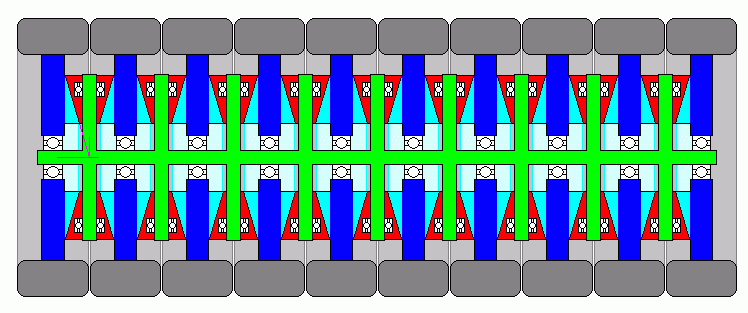How we invented the most senseless and merciless differential
Hello, my name is Nikolai and I’m an alcoholic… worse, I’m an accomplice and organizer of the invention of a differential for a road roller (yes, the word “accomplice” fits best here, because we still need to look for such crimes against logic and common sense…)
It all started as always: summer, vacation, bike rides and, of course, crazy ideas. As a rule, inspired by the surrounding reality – in this case, the state of the roads from which we have just returned. Green tea stimulated the relaxation of tired legs and the activation of the previously fiddling head, while the legs dragged it along the gullies. In this state, the craziest creative ideas arise regarding transport in general – and off-road vehicles in particular.
The main disadvantage of any drive, even 4×4, is that it creates two tracks. Sooner or later, any technology will fall on its belly. What should it be like, the off-road “ide of my dreams”? By prior agreement, as part of an organized group, we committed a brutal murder of common sense (my friend at first resisted a little, but the famous sadist Madame Boredom quickly explained to him what happens to those who go against the will of the leader) – of course, the car should have front and rear two full-width skating rinks! Then she won’t be able to “trample” anything on the road that she couldn’t then walk through herself. And even a little bit will be able to level the road for simpler vehicles.
Logic fell next. Yes, it is not viable. Nonsense, let's pull it by the ears! Let's heroically solve all the problems we just created!
– How will it turn?
– Oh, this is the easiest question! For simpler vehicles, we simply turn the entire roller (the dimensions of the front arches? To hell with them!), for cooler vehicles, the front half of the articulated frame!– Where will it get traction from the road, it’s a roller!
– Nothing complicated either! Let's make a skating rink from car wheels! So what if you have to change shoes for the season on two “caterpillars” of 10 tires each… But the entire skating rink will have a “mud” tread!– What will happen when it hits the road?
— Oh… he needs a differential…
A differential that allows the wheels to rotate “at odds,” but does not allow any one wheel hanging over the pit to turn in vain (and as is easy to see, this will be a completely normal state for a skating rink made up of individual wheels). An absolutely fascinating engineering challenge. I invite the reader to pause here and think about how he would solve it. Hint: it’s all about the correct formulation of the technical specifications.
Did you manage? Well, of course, you just need to set the problem as narrowly as possible: the difference in angular velocities between two adjacent wheels should be the same throughout the entire skating rink. This is more than enough to enter a corner: if the outside wheel rotates at 109% and the inside at 91%, then the remaining 8 should represent a range of 93%, 95%, 97%, 99%, 101%, 103%, 105% and 107%.
Hearing this formulation, the friend instantly perked up and dealt a blow of mercy to the agonizing Common Sense and Logic with the crooked robber knife of his sharpened thought. You just need to put all the wheels on a common free axle and connect the neighboring ones in pairs through a gear sitting on the axle. Like this:

No, really. Crosspieces (also green) sit on a common axis (green), and bevel equalizing gears (red) rotate freely on them (like satellites on a carrier in a planetary gear). Wheels (blue) sit freely on the same axle, made integrally with their bevel gears (blue). All this is conveniently hidden inside the tires (all shades of gray). As it is easy to see, each subsequent wheel can overtake each previous one by exactly the same angular value, because the axle with the equalizing satellites hanging on it will rotate by half this amount – and they all have the same axle.
Now it’s enough just to set the outer wheels in motion with a regular differential, and the structure will move as long as at least two wheels out of ten have good grip on the ground (as, in fact, a regular differential does – but of the two wheels, one remains alone much easier than ten).
— How much dirt will this dividing shaft pick up, and directly into the gears? How do you change punctured tires? But how do you at least assemble it, pull out each crosspiece, or what?
– Logic and common sense, are you here again? Where? Are you dead?
In short, if someone has absolutely nothing to do in the summer and has a barn full of possibilities, like Doctor Dew’s, this daredevil can try to assemble and put one such roller on the back of a quad. It will be fun (that's for sure), and not in the same sense as in Dwarf Fortress (but that's not for sure). It’s hard to say where to get so many gears from; even the guy from Factorio doesn’t have that many. Apparently, we need an uncle watchman from the gear factory.
The offer to donate the Lunokhod frame to any daredevil who has three motor wheels of the required size (or somewhere to remove them for the duration of the experiments) also remains in force. Small variations are possible with cities. Spoiler: Lunokhod had prototypes on YouTube, briefly mentioned in the introduction; whoever finds the most structurally similar one is a great guy, we failed (perhaps the video was deleted a long time ago).




![The art of ETL. Writing our own SQL engine in Spark [часть 6]](https://prog.world/wp-content/uploads/2024/04/x1lx17qduwak6ilxb0z0y6y0srg-768x461.png)